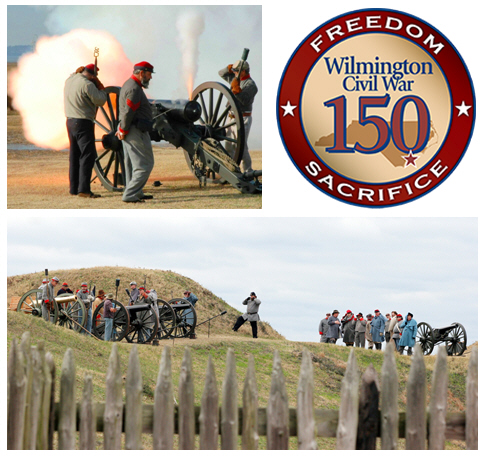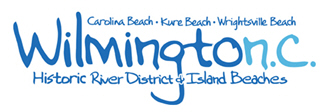| Wilmington,
NC – December 2014 / Newsmaker Alert / The year 2015 marks important
anniversaries in American history: the 150th anniversary of the end of
the American Civil War and the dawn of Emancipation. Did you know that
when it comes to Civil War history, Wilmington,
North Carolina and its beaches are among the most historically significant
destinations in the United States? In fact, the 2012 film “Lincoln”
made multiple references to Wilmington and the Battle of Fort Fisher.
Until the last few months
of the Civil War, Fort Fisher kept North Carolina’s port of Wilmington
open to blockade-runners supplying necessary goods to Confederate armies
inland. By 1865, the supply line through Wilmington was the last remaining
supply route open to Robert E. Lee’s Army of Northern Virginia. When Fort
Fisher fell after a massive Federal amphibious assault on January 15, 1865,
its defeat helped seal the fate of the Confederacy. The Confederate forces
surrendered, opening the way for a Federal thrust against Wilmington, North
Carolina, the South’s last open seaport of the Atlantic coast. Union troops
moved inland and occupied homes and structures.
|
 |
|
Other area attractions that
interpret Wilmington’s role during the Civil War include historic homes,
museums, cemeteries, and landmarks that feature different perspectives
on the war’s events and consequences, and the role that Wilmington played
in shaping the war. The Wilmington and Beaches Convention and Visitors
Bureau has created a special website www.WilmingtonCivilWar150.com
where visitors can learn more about Wilmington’s Civil War history and
use it as a comprehensive guide with links to maps and information about
Civil War attractions
and exhibits, monuments
and markers, events,
educational
symposiums, special lodging
rates and packages.
Attractions with Civil
War History:
Bellamy Mansion, a
fine example of antebellum architecture, was completed on the eve of the
Civil War and occupied by Federal troops during the 1865 occupation of
Wilmington. The mansion now serves as a museum of history and the design
arts, offering daily tours and educational/cultural programs year-round.
Tour the magnificent 10,000-square-foot home, visit the meticulously-recreated
gardens, and walk through the recently restored Slave Quarters, one of
very few preserved urban slave quarters in the country. www.bellamymansion.org
Cameron Art Museum
is located on the site where the Battle of Forks Road was fought in February,
1865. A NC Civil War Trails historical marker identifies the location of
the “Forks Road Engagement” where Major General Robert F. Hoke made his
last stand against Union soldiers comprised primarily of U.S. Colored Troops.
Each year in February the museum reenacts this significant 3-day skirmish
with a Civil War Living History weekend event (Feb. 7-8, 2015). For more
information about this year’s event: battleofforksroad.org
Cape Fear Museum of History
& Science, N.C.’s oldest history museum, was founded in 1898 by
the United Daughters of the Confederacy to preserve Civil War history.
Its collection includes an interactive diorama of the Battle of Fort Fisher
and hundreds of artifacts, many of which will be on display in a special
collections exhibit Fort Fisher: 100 Years from Dec. 15 through July 13.
www.capefearmuseum.com
Fort Fisher State Historic
Site kept the port of Wilmington open to blockade-runners supplying
goods to Confederate armies. When Fort Fisher fell on January 15, 1865,
its defeat helped seal the fate of the Confederacy. Today Fort Fisher is
a state historic site that welcomes visitors year-round to explore the
Civil War battlefield and gigantic earthworks, museum exhibits, outdoor
monuments, and a 1/4 mile interpretive trail around the fort. Educational
programs and artillery demonstrations are offered throughout the year.
The Fort’s annual Anniversary Observance takes place in mid-January with
reenactments and special programs. For more information about this year’s
grand 150th Anniversary event, visit www.friendsoffortfisher.com and www.nchistoricsites.org/fisher.
Fort Fisher Underwater
Archeology Center has uncovered historic gems dating back to the Civil
War era, including the remains of 29 Civil War period shipwrecks off the
coast of southeast NC. Most were blockade runners attempting to evade the
Union ships and enter the Cape Fear River. Divers have also located four
sunken Union warships and two Confederate gunboats. www.arch.dcr.state.nc.us/ncarch/underwater/underwater.htm
Oakdale Cemetery,
established in 1852, was open for burials in 1855. Within the grounds you
will find the graves of Civil War Generals such as Whiting, Barry and MacRae
to name a few. Confederate spy Rose O’Neale Greenhowe is also laid to rest
here and there is an impressive monument to the Confederate Dead, overlooking
the 367 graves within its enclosure. www.oakdalecemetery.org
Orange Street Landing
on Cape Fear was dedicated in May 2005 as part of the National Underground
Railroad Network to Freedom. Wilmington’s largest known escape took place
here in September 1862, when 22 freedom-seekers confiscated three sailboats
and rowed 28 nautical miles to the mouth of the Cape Fear River. A kiosk
interprets this freedom story. www.wilmingtonnc.gov/Home/News/tabid/429/ItemID/406/View/Details/Default.aspx
Sugarloaf Sand Dune at
Carolina Beach State Park. Hike the Sugarloaf Trail (a 3-mile journey
beginning at the marina parking lot) that leads to the giant Sugarloaf
sand dune where up to 6,400 Confederate troops under Major General Robert
F. Hoke were encamped in defensive positions during the siege of Fort Fisher.
www.ncparks.gov/Visit/parks/cabe/main.php
Thalian Hall Center for
Performing Arts (c.1855-1858) serves as the city’s political and cultural
center. During the Civil War, Thalian Hall was in almost constant use as
a place of amusement for soldiers and locals alike. It was built by freed
and enslaved Africans. The theatre’s main stage makes an appearance in
the upcoming Smithsonian Channel documentary “Lincoln’s Last Day.” Thalian
Hall’s designer John Montague Trimble is believed to have been involved
in the design of Ford Theatre which may explain why they look so similar.
www.thalianhall.org
Wilmington National Cemetery
(c.1867). Civil War soldiers’ remains were reinterred to the National Cemetery
from the Wilmington City Cemetery, Fort Fisher, and surrounding areas.
The remains of the 557 U.S. Colored Troops (55 known, 502 unknown) who
died on the advance to Wilmington are buried in the northwest corner of
the cemetery. Their grave markers are identified with the inscription “U.S.C.T.”
or “U.S. Col. Inf.” A state highway marker honors the USCT soldiers buried
here. www.ncmarkers.com/Markers.aspx?MarkerId=D-111
Wilmington Railroad Museum
is housed in an authentic 1883 railroad freight warehouse. During the Civil
War, the Wilmington and Weldon line was essential to the Confederacy and
was referred to as the “Lifeline of the Confederacy.” The line moved goods
and supplies from the single open Confederate port of Wilmington to Robert
E. Lee’s Army in Virginia and throughout the Confederacy. The museum interprets
Wilmington’s railroad history. www.wrrm.org
Nearby: Brunswick Town/Fort
Anderson in Winnabow, N.C. was constructed atop the old Colonial village
site of Brunswick Town during the Civil War and served as part of the Cape
Fear River defenses below Wilmington before the fall of the Confederacy.
Colonial foundations dot the present-day tour trail, which crosses the
earthworks of the Confederate fort. On February 14-15, Fort Anderson will
commemorate the 150th Anniversary of the Fall of Fort Anderson with a weekend
of special events and programs.
www.nchistoricsites.org/brunswic/brunswic.htm
Nearby: Poplar Grove Plantation
in Scotts Hill, N.C. is one of the oldest existing peanut plantations in
North Carolina. The Foy family purchased the land in 1795 and kept it until
the mid-1970s. Visitors can tour the 1850 manor house and observe farm
animals, exhibits and live craft demonstrations typical of an 1800s working
plantation. A new exhibit “From Civil War to Civil Rights: The African
American Experience at Poplar Grove” chronicles the lives of African Americans
on-site at Poplar Grove from slavery to the early Civil Rights movement.
(Note: Poplar Grove will close for the season on Dec. 12 and will reopen
March 2, 2015). www.poplargrove.org
Tours That Specialize
in Civil War History:
*Cape Fear Historical
Institute offers a guided “Confederate Wilmington Walking Tour” (by
reservation only) that highlights people, historic buildings and events
of the ante-bellum and wartime era. A special “General Hoke and the Wilmington
Campaign Tour” will be offered on January 10. To reserve a guided Civil
War tour of historic Wilmington, contact CFHI at 910-619-4619 or bernhard1848@gmail.com.
Website: www.cfhi.net.
*Wihi App Tours: A
new app tour is available for visitors who prefer a self-guided tour of
Civil War sites at www.wihi.info/civil-war-wilmington.
“wihi” (short for Wilmington History) offers a “Civil War Wilmington” tour
on its app that uses the technology of a cell phone or tablet to show history
like you’ve never seen it before. To find out more about the wihi app and
its history tours, visit the website www.wihi.info.
Events with Civil War
Themes:
Civil War themed events continue
through 2014, culminating in 2015 with exhibits, tours, programs, an Educational
Civil War Symposium (Feb. 27-28), a National Medal of Honor Commemoration
(March 22), and two large-scale living history events. The 150th Anniversary
of the Battle of Fort Fisher: Nor Shall Your Glory Be Forgot (Jan.
17-18) will feature two battle reenactments, night artillery firing, special
daytime and nighttime lantern tours, historian presentations, and a memorial
service at the Fort Fisher State Historic Site near Kure Beach. There will
also be a Descendants’ Reunion on January 15-16. For more information,
visit www.friendsoffortfisher.com
and www.nchistoricsites.org/fisher.
In February, the Battle of Forks Road Living History Weekend (Feb.
7-8) will feature a reenactment on the grounds of the Cameron Art Museum
where this important skirmish was fought. On February 14-15, Fort Anderson
will commemorate the 150th Anniversary of the Fall of Fort Anderson
with a weekend of special events, reenactments and programs. Details for
these and other Civil War events, exhibits, symposiums and observances
are online at www.WilmingtonCivilWar150.com.
Visitors are advised to check the website often for updates.
Museums, attractions, tours
and events provide a fun and affordable way to experience a region’s history
and culture. Wilmington, N.C.’s historic river district and the island
beaches of Carolina Beach,
Kure
Beach and Wrightsville
Beach offers one destination with four unique settings. Wilmington
is an easy drive from I-95 via I-40 and US74. Prefer to fly? The Wilmington
International Airport (ILM) is located only 10 minutes from the river and
20 minutes from the beach. For general visitor information, visit www.GoWilmingtonAndBeaches.com,
where you’ll also find a complete Event Calendar. To request a free Official
Visitors Guide call 1-866-266-9690 or email visit@wilmingtonandbeaches.com.
Media
Contact:
Wilmington
and Beaches Convention & Visitors Bureau
Connie
Nelson
Communications/PR
Director
910-332-8751
866-266-9690
ext. 120
|
The
New Hanover County Tourism Development Authority d/b/a Wilmington and Beaches
Convention and Visitors Bureau is the official destination marketing organization
of New Hanover County, North Carolina that stimulates economic development
through the promotion of travel and tourism.
|

|








